Czech nobility
Czech nobility consists of the noble families of the historical states of the Czech Republic that include Bohemian nobility, Moravian nobility and Silesian nobility. These are connected with the history of Great Moravia, Duchy of Bohemia, later Kingdom of Bohemia, Margraviate of Moravia, the Duchies of Silesia and the lands of the Bohemian Crown, the constitutional predecessor state of the modern-day republic.
Aristocracy was abolished by law (No. 61/1918 Sb. z. a n.)[1] in December 1918, shortly after the establishment of the independent Czechoslovak Republic.
List of noble families (incomplete)
- z Aichelburka
- Bavorové ze Strakonic
- Belcrediové
- Bibrové
- z Boskovic
- Bořkové-Dohalští
- z Bubna
- Chorinští z Ledské
- Clary-Aldringenové
- Colloredo-Mansfeldové
- Černínové
- Chotkové
- Deymové ze Stříteže
- Dobřenští
- z Dubé
- Berkové z Dubé
- z Jelení
- Hildprandtové
- Harrachové
- z Hradce
- Kameničtí z Kamenice
- Kinští
- Koldicové z Koldic
- Kolovratové
- Kounicové
- Krajířové
- z Kravař
- z Kunštátu
- Lichtenburkové
- Lichtenštejnové
- Lannové
- Larischové
- Lichnovští
- z Lipé
- Lobkovicové
- Lomnicové
- Martinicové
- Neubergové
- Nosticové
- Paarové
- Parishové
- Pernštejnové
- Piccolominiové
- z Poděbrad
- Přemyslid dynasty
- Rohanové
- Ronovci
- Rožmberkové
- Švihovští z Rýzmberka
- Slavatové z Chlumu a Košumberka
- Slavník dynasty
- Smiřičtí ze Smiřic
- Šlikové
- Schwarzenbergové
- Šporkové
- Šternberkové
- Strakoš family
- Švamberkové
- Tetourové z Tetova
- Trčkové z Lípy
- Thun-Hohensteinové
- Valdštejnové
- Vítkovci
- z Vlašimi
- Jankovští z Vlašimi
- Vratislavové z Mitrovic
- Vršovci
- Zajícové z Hazmburka
- Zedwitzové
- Žerotínové
Gallery
 George of Kunštát and Poděbrady (1420–1471), the only Bohemian lord who managed to gain the royal rank (via election), remembered especially for his proposal to create peaceful all-European union of Christian states
George of Kunštát and Poděbrady (1420–1471), the only Bohemian lord who managed to gain the royal rank (via election), remembered especially for his proposal to create peaceful all-European union of Christian states Hagecius (1525–1600), astronomer, naturalist and personal physician of Emperor Rudolph II, who invited de Brahe and Kepler at Prague to scientific collaboration
Hagecius (1525–1600), astronomer, naturalist and personal physician of Emperor Rudolph II, who invited de Brahe and Kepler at Prague to scientific collaboration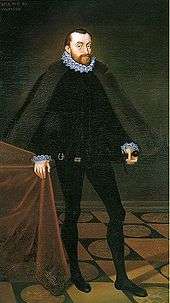 Petr Vok of Rosenberg (1539–1611), the last descendant of powerful and wealth "viceroyal" Rožmberk family, benefactor of the oldest Protestant church Unity of the Brethren
Petr Vok of Rosenberg (1539–1611), the last descendant of powerful and wealth "viceroyal" Rožmberk family, benefactor of the oldest Protestant church Unity of the Brethren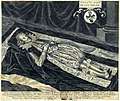 Albrecht Jan Smiřický of Smiřice (1594–1618), the wealthiest lord of its era, possible candidate to the Bohemian throne and one of main heads of the anti-Habsburg Bohemian Revolt
Albrecht Jan Smiřický of Smiřice (1594–1618), the wealthiest lord of its era, possible candidate to the Bohemian throne and one of main heads of the anti-Habsburg Bohemian Revolt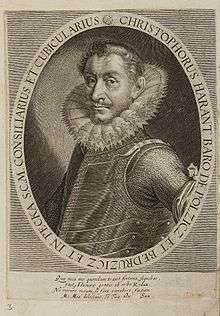 Kryštof Harant of Polžice and Bezdružice (1564–1621), renowned traveler, humanist and composer was executed because of his involvement in finally unsuccessful Bohemian Revolt
Kryštof Harant of Polžice and Bezdružice (1564–1621), renowned traveler, humanist and composer was executed because of his involvement in finally unsuccessful Bohemian Revolt- Albrecht Václav von Wallenstein (1583–1634), famous military leader and politician during the Thirty Years War, the first holder of title generalissimo in history
.jpg) Polyxena of Lobkowicz (1566–1642), née Pernštejn, most powerful and influential noblewoman of Early Modern Age in Czech history, her political engagement and intrigues have greatly helped forcible re-Catholization of Bohemia after 1620
Polyxena of Lobkowicz (1566–1642), née Pernštejn, most powerful and influential noblewoman of Early Modern Age in Czech history, her political engagement and intrigues have greatly helped forcible re-Catholization of Bohemia after 1620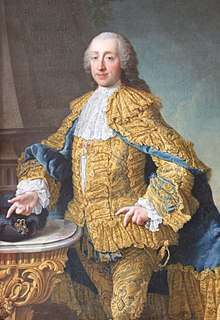 Václav Antonín of Kaunitz-Rietberg (1711–1794), statesman and diplomat, state chancellor of the Habsburg Monarchy, initiator of the Diplomatic Revolution
Václav Antonín of Kaunitz-Rietberg (1711–1794), statesman and diplomat, state chancellor of the Habsburg Monarchy, initiator of the Diplomatic Revolution- Kašpar Maria of Sternberg (1761–1838), botanist, geologist, paleobotanist and founder of the Bohemian National Museum in Prague (1818)
 Josef Václav Radetzky von Radetz (1766–1858), Austrian field marshal and viceroy of Lombardy–Venetia, "saviour of the House of Habsburg" during the revolution year of 1848 in Italy
Josef Václav Radetzky von Radetz (1766–1858), Austrian field marshal and viceroy of Lombardy–Venetia, "saviour of the House of Habsburg" during the revolution year of 1848 in Italy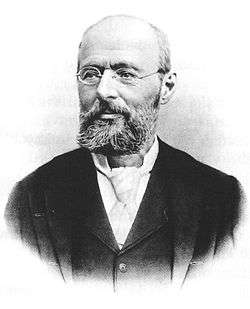 Emil Škoda (1839–1900), knighted entrepreneur and engineer, founder of famous Škoda Works – one of the largest European industrial conglomerates and arms producer of the 20th c.
Emil Škoda (1839–1900), knighted entrepreneur and engineer, founder of famous Škoda Works – one of the largest European industrial conglomerates and arms producer of the 20th c.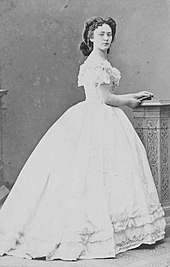 Bertha von Suttner (1843–1914), née Kinsky, peace activist and writer, the first woman awarded the Nobel Peace Prize (1905) and probably the most known noblewoman of Bohemian origin
Bertha von Suttner (1843–1914), née Kinsky, peace activist and writer, the first woman awarded the Nobel Peace Prize (1905) and probably the most known noblewoman of Bohemian origin
Notes
- Exact wording of this "Law of 10 December 1918, which abolished the nobility, medals and titles" is available on the Czech Wikisource
Further reading
- von Dobrá Voda, Adalbert Král (1904). Der Adel von Böhmen, Mähren und Schlesien [Aristocracy of Bohemia, Moravia and Silesia] (PDF) (in German). Prag: I. Taussig. Retrieved February 14, 2016.
- von Meraviglia-Crivelli, Rudolf Johann (1886). Der böhmische Adel [Bohemian Aristocracy] (PDF) (in German). Nürnberg: Bauer und Raspe. Retrieved February 14, 2016.
- von Kadich, Heinrich Edlen; Blažek, Conrad (1899). Der mährische Adel [Moravian Aristocracy] (PDF) (in German). Nürnberg: Bauer und Raspe. Retrieved February 14, 2016.
- Blažek, Conrad (1887–1894). Der abgestorbene Adel der Provinz Schlesien und der O. Lausitz [Extinct Aristocracy of the Province of Silesia and Upper Lusatia] (in German). I–III. Nürnberg: Bauer und Raspe.
- Pilnáček, Josef (2010). Rody starého Slezska [Families of Ancient Silesia] (in Czech) (3rd ed.). Brno: Ivo Sperát. ISBN 978-80-904312-3-2.
gollark: <@356107472269869058> Make me admin so I can do this please.
gollark: I don't have sufficient power.
gollark: Definitions are irrelevant to most arguments because they're downstream of use.
gollark: I mean, someone gets bored eventually.
gollark: It's doomed to run on forever without resolving whatsoever.
This article is issued from Wikipedia. The text is licensed under Creative Commons - Attribution - Sharealike. Additional terms may apply for the media files.
